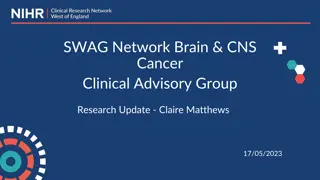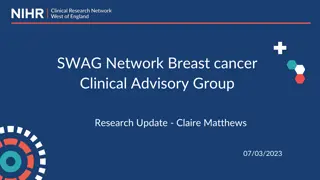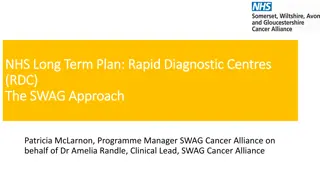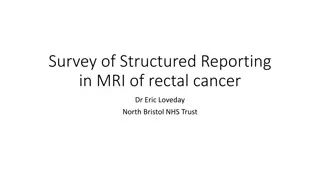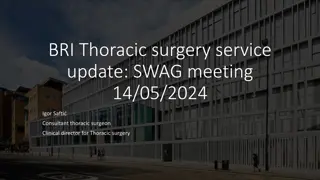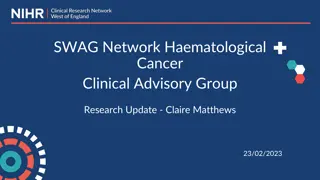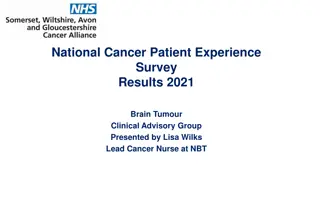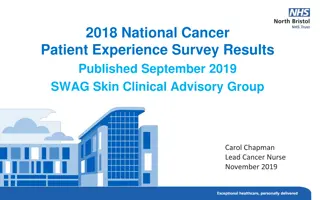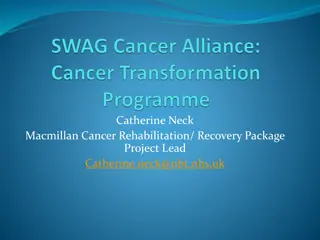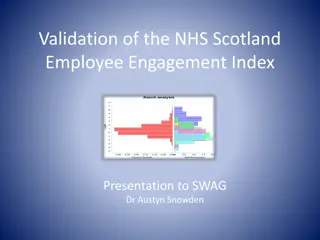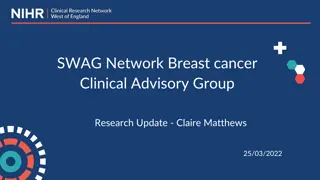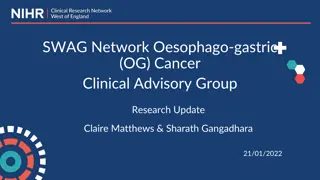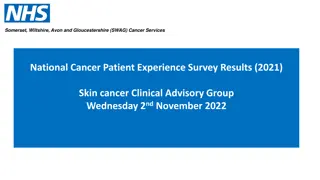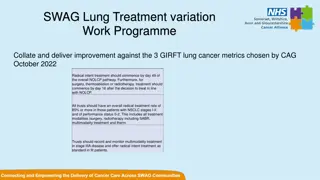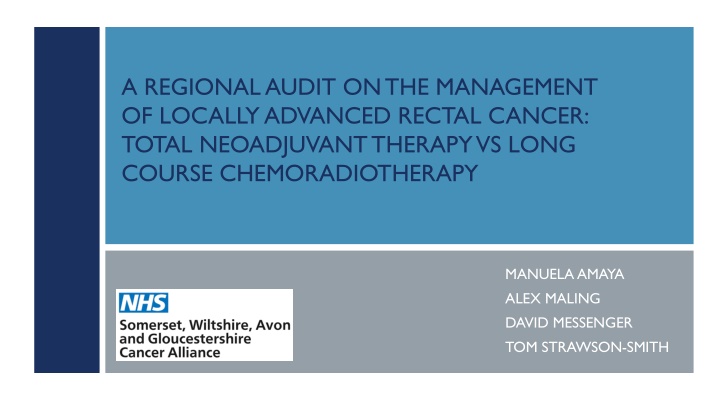
Regional Audit on Management of Locally Advanced Rectal Cancer: Total Neoadjuvant Therapy vs Long Course Chemoradiotherapy
Explore the comparison between total neoadjuvant therapy and long course chemoradiotherapy for locally advanced rectal cancer through regional audit findings. Discover the practice-changing trials, trials updates, and outcomes of landmark trials like RAPIDO and PRODIGE-23. Learn about organ preservation strategies, patient outcomes, and the evolving landscape of neoadjuvant therapy in rectal cancer management.
Download Presentation

Please find below an Image/Link to download the presentation.
The content on the website is provided AS IS for your information and personal use only. It may not be sold, licensed, or shared on other websites without obtaining consent from the author. If you encounter any issues during the download, it is possible that the publisher has removed the file from their server.
You are allowed to download the files provided on this website for personal or commercial use, subject to the condition that they are used lawfully. All files are the property of their respective owners.
The content on the website is provided AS IS for your information and personal use only. It may not be sold, licensed, or shared on other websites without obtaining consent from the author.
E N D
Presentation Transcript
A REGIONAL AUDIT ON THE MANAGEMENT OF LOCALLY ADVANCED RECTAL CANCER: TOTAL NEOADJUVANT THERAPY VS LONG COURSE CHEMORADIOTHERAPY MANUELA AMAYA ALEX MALING DAVID MESSENGER TOM STRAWSON-SMITH
Background Practice changing trials 2024 update OUTLINE Previous local audits Regional Project
BACKGROUND TNT VS LCCRT High Risk Features Use of total neoadjuvant therapy for high risk LARC followed by surgery, or adopting a non-operative T3/4 CRM + Enlarged lateral LNs N2 EMVI + management (NOM) approach Landmark trials: RAPIDO, PRODIGE-23, OPRA Improved disease-free survival, overall survival and rates of organ preservation Substantial variation in the choice of TNT sequence and regimen across the world
PRACTICE CHANGING TRIALS The Changing Landscape of Neoadjuvant Therapy in Rectal Cancer. May 2021. BSMO meeting 2021.
ORGAN PRESERVATION OPRA Trial Phase 2 RCT Compared timing of LCCRT and NAC (CAPOX or FOLFOX) induction vs consolidation Patients with cCR or near cCR were assigned to watch and wait (WW) Patients with an incomplete response and residual tumour underwent TME No difference in 3-year DFS between groups WW in patients who achieve a cCR is a viable treatment strategy 50% of patients
RAPIDO PRODIGE-23 Clinical Outcomes (Exp vs Std) (Exp vs Std) Primary endpoint 3-yrs DrTF 3-yrs DFS TRIAL UPDATES 3-yrs primary event 5-yrs 7-yrs 23.7% vs 30.4% (6.7%) 27.8% vs 34% (7%) 76% vs 69% (7%) 73.1% vs 65.5% (7.6%) 67.7% vs 62.5% HR (95% CI) p value 0.75 (0.6 0.96) p=0.019 0.69 (0.49-0.97) p= 0.034 pCR rate 28.4% vs 14.3% 27.5% vs 11.7% Local relapse rate 8.7% vs 5.4% at 3 yrs 11.7% vs 8.1% at 5yrs P = 0.007 5.3% vs 8.1% at 7 years Distant relapse rate 23% vs 30.4% at 5 yrs 20.7% vs 27.7% at 7 years 3-yrs OS 5-yrs OS 7-yrs OS 89.1% vs 88.8% 81.7% vs 80.2% 90.8% vs 87.7% 86.9% vs 80% 81.9% vs 76.1%
PREVIOUS LOCAL AUDITS UHBW: Single Centre Experience of Total Neoadjuvant Therapy Compared with Long Course Chemoradiotherapy (LCCRT) Alone for Locally Advanced Rectal Cancer 2021 - 2022 Somerset FT: Total Neoadjuvant Therapy for Rectal Cancer A review of local data 2021-2024
RESULTS BASELINE CHARACTERISTICS SFT (n = 60) MPH (n= 38) YDH (n=22) 3 years 2021 - 2024 UHBW (n = 41) 2 years 2021-2022 TNT Median Age (years) 62 60 Performance Status (%) 0 1 75 25 76 24 CRM + (%) 43 46 T3 (%) T4 (%) N2 (%) 67 20 37 75 15 51 EMVI + (%) 67 64
TREATMENT PROTOCOL NUMBER OF PATIENTS 40 37 35 32 30 25 20 20 15 10 5 4 5 3 0 LCCRT & NAC PRODIGE RAPIDO SFT UHBW
OUTCOMES COMPLETE RESPONSE RATES & WW Bristol SFT Declined surgery (%) Watch & Wait (%) pCR (%) rCR - TRG1 (%) 0 5 10 15 20 25 30 35
CONCLUSIONS & FUTURE WORK UHBW - Higher rates of pCR in TNT but similar rates of organ preservation vs LCCRT - Long term recurrence data needed to confirm outcomes - Audit local watch and wait practice and outcomes SOMERSET FT - Outcomes similar to trials (although short follow up period) - Long term follow up needed - Evaluate outcomes for patients treated with LCCRT alone
REGIONAL AUDIT - PROJECT AIMS & OBJECTIVES 1. To establish current practise of LARC across SWAG Network 2. Compare outcomes between TNT and LCCRT 3. Establish tolerability of neoadjuvant treatment 4. Assess current watch and wait practices 5. Suggest regional clinical guidelines
METHODS Regional audit - SWAG Trusts Lead in each trust with supervising consultant if lead is a trainee Local lead responsible for registering audit locally, and identifying patients from surgical, radiotherapy and chemotherapy databases Data collection via REDCap - https://redcap.uhbw.nhs.uk/
INCLUSION/EXCLUSION CRITERIA Adults >18 years Histological and/or radiological diagnosis of locally advanced rectal cancer (metastatic patients excluded) Rectal radiotherapy between January 2021 and December 2023 : TNT or LCCRT alone Patients on Watch & Wait protocol any treatment between January 2013 and December 2023
AUDIT CRITERIA Total neoadjuvant therapy should be offered to patients with rectal tumours with any of the following features; T3, T4, N1, N2, EMVI and/or 1. tumour deposits, and threatened or involved CRM or inter-sphincteric plane. Assessment of clinical response in patients treated with TNT should be performed within 8 (+/-) 4 weeks after TNT if treated with LCCRT, 2. within 2- 4 weeks after TNT if SCRT used, and within 8 (+/-) 2 weeks if treated with LCCRT alone. Patients who achieve a complete clinical response should be offered a discussion regarding the risks and benefits of NOM. 3. Patients on W&W protocol should have clinical examination OR flexible sigmoidoscopy every 3-6 months for 2 years, then every 6 months 4. for a total of 5 years AND MRI rectum every 6 months for up to 3 years, AND CT chest/abdomen every 6 to 12 months for a total of 5 years. Pathological complete response rates in patients treated with TNT should be at least 28% 5. Local recurrence rates of less than 8% at 3 years in TNT patients 6.
AUDIT TIMELINE November 2024: Identification of study lead from each trust, and distribution of protocol. December 2024: : REDCap user account registration and identification of eligible patients. January 2025 to April 2025: Data Collection to be complete by 30th April 2025 May 2025 to July 2025: : Data analysis and submission of abstracts for publication
REFERENCES 1. Neoadjuvant chemotherapy with FOLFIRINOX and preoperative chemoradiotherapy for patients with locally advanced rectal cancer (UNICANCER-PRODIGE 23): a multicentre, randomised, open-label, phase 3 trial Conroy, ThierryBorg, Christophe et al.The Lancet Oncology, Volume 22, Issue 5, 702 715 2. Short-course radiotherapy followed by chemotherapy before total mesorectal excision (TME) versus preoperative chemoradiotherapy, TME, and optional adjuvant chemotherapy in locally advanced rectal cancer (RAPIDO): a randomised, open-label, phase 3 trial Bahadoer, Renu R stergaard, L. et al. The Lancet Oncology, Volume 22, Issue 1, 29 42 3. Total neoadjuvant therapy with mFOLFIRINOX versus preoperative chemoradiation in patients with locally advanced rectal cancer: 7-year results of PRODIGE 23 phase III trial, a UNICANCER GI trial.. Conroy, ThierryBorg, Christophe et al. JCO 41, LBA3504-LBA3504(2023). 4. Organ Preservation in Patients With Rectal Adenocarcinoma Treated With Total Neoadjuvant Therapy. Garcia- Aguilar, Julio et al. Journal of clinical oncology : official journal of the American Society of Clinical Oncology vol. 40,23 (2022): 2546-2556. doi:10.1200/JCO.22.00032 Total Neoadjuvant Treatment for Locally Advanced Rectal Cancer Patients: Where Do We Stand? Valentina Dapr et al. Int. J. Mol. Sci. 2023, 24(15), 12159;


